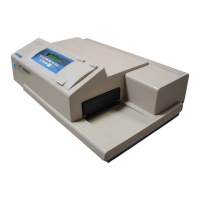Operation
52 0112-0115 F
Optimizing Luminescence Assays
Luminescence may be read from the top or the bottom of a microplate
or the cuvette. Solid white plates or white plates with clear bottoms are
recommended for luminescence reads.
For standard luminescence a separate light path without
monochromators carries the emitted light to a dedicated PMT. The
optimum emission wavelength is between 360 and 630 nm. Under
reader set-up the emission says “All”.
For wavelength-selectable luminescence, the emission monochromator
is used to differentiate the wavelengths being emitted from the well. Up
to four emission wavelengths between 250 nm and 850 nm may be
specified. If reading only one luminescent event in the well, best
sensitivity should be achieved using the standard luminescence
measurement, without a wavelength selected.
Luminescence read times are not designated by multiple reads per well,
but rather by choosing the total integration time desired between 1 ms
and 1,500 ms. Typical luminescence assays require between 500 ms
and 1,000 ms integration.
If wells have been incubating for a long period of time, it is a good idea
to mix the plate before reading. This can be done using Automix in the
reader.
If it appears that the signal is always higher in the first wells read (for
example, column A), the plate may need to be “dark adapted” to
reduce the auto-luminescence of the white plastic. The auto-
luminescence decreases quickly, so manually load the plate from the
control panel and wait for 1–2 minutes before initiating the read and
determine if the read-out is more consistent across the plate.

